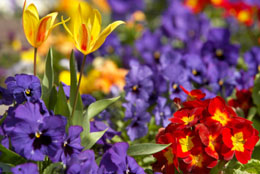Flowers are a beautiful creation to behold. There are a large variety of flowers found all around the world. Learn more about the primary classification of flowers along with their different parts in this Buzzle article.

Flowering plants have a wide importance in our lives. There are different kinds of flowers that are used for various purposes. While some are utilized for decorations during weddings, birthdays, or other special occasions, some are used for medicinal purposes. Flowers are bundled into attractive bouquets, which are used as a means of decoration or can be given off as gifts too. Flowers bring along joy with their beautiful colors and their mesmerizing fragrance. They act as a source of joy for everyone.
Different Kinds of Flowers
Scientifically speaking, a flower is nothing but the reproductive structure of the plant. The flower contains the male pollen and/or the female ovule in addition to the accessory parts, which are the petals, sepals, and the nectar glands. In terms of botanical studies, flowers can be classified into different types and categories based on several similarities and differences between them.
Parts of a Plant
The pistil is the female part of the plant, which is shaped like a bowling pin. The pistil is an entire assembly of several parts, which include the stigma, style, and the ovary of the flower. The stigma is located at the top of the flower, and it is connected to the ovary by means of the style, which is a long, slender, tube-like structure. The ovary of the flower contains ovules that have to be fertilized in order to develop into a seed. The stamen is the male reproductive part of the flower, which consists of a pollen sac and a long supporting filament. Sepals are green, leaf-like structures that are present at the base of the flower. The sepals protect the flower bud, and are collectively referred to as the calyx. The petals are the colorful portion of the flower, that often contain perfume as well as nectar glands. The petals are collectively called corolla.
Perfect Flowers
Bisexual flowers are also called perfect flowers and consist of both male as well as female reproductive parts. Flowers that contain the androecium as well as the gynoecium are androgynous or hermaphroditic flowers. Examples of perfect flowers include the lily, cherry flower, and rose, to list a few. Bisexual flowers contain petals, sepals, pistil, and stamen. They do not require to have any features for promoting pollination, since the reproductive process can be taken care of in the same plant itself, with both the male and female parts located close to each other.
Imperfect Flowers
Flowers that contain only one type of reproductive organ, either male or female, are called imperfect flowers. The ones that contain the androecium or the stamens alone are called male flowers, whereas the ones that contain the gynoecium alone are called the female flowers. The imperfect flowers need specialized characteristics that will attract pollinating agents or facilitate the pollination process in one way or the other. Brightly colored petals or enhanced lengths of styles and stamens are some of the characteristics that certain flowers need to develop in order to facilitate pollination.
These are the chief types of flowers according to the botanical definitions. In addition to this, flowers are also differentiated into more specialized groups and types by studying their anatomies and referring to the scientific nomenclature and classification systems.






 Flowering plants have a wide importance in our lives. There are different kinds of flowers that are used for various purposes. While some are utilized for decorations during weddings, birthdays, or other special occasions, some are used for medicinal purposes. Flowers are bundled into attractive bouquets, which are used as a means of decoration or can be given off as gifts too. Flowers bring along joy with their beautiful colors and their mesmerizing fragrance. They act as a source of joy for everyone.
Flowering plants have a wide importance in our lives. There are different kinds of flowers that are used for various purposes. While some are utilized for decorations during weddings, birthdays, or other special occasions, some are used for medicinal purposes. Flowers are bundled into attractive bouquets, which are used as a means of decoration or can be given off as gifts too. Flowers bring along joy with their beautiful colors and their mesmerizing fragrance. They act as a source of joy for everyone.